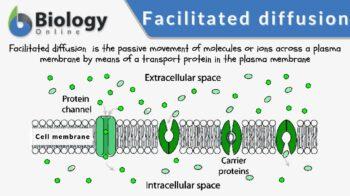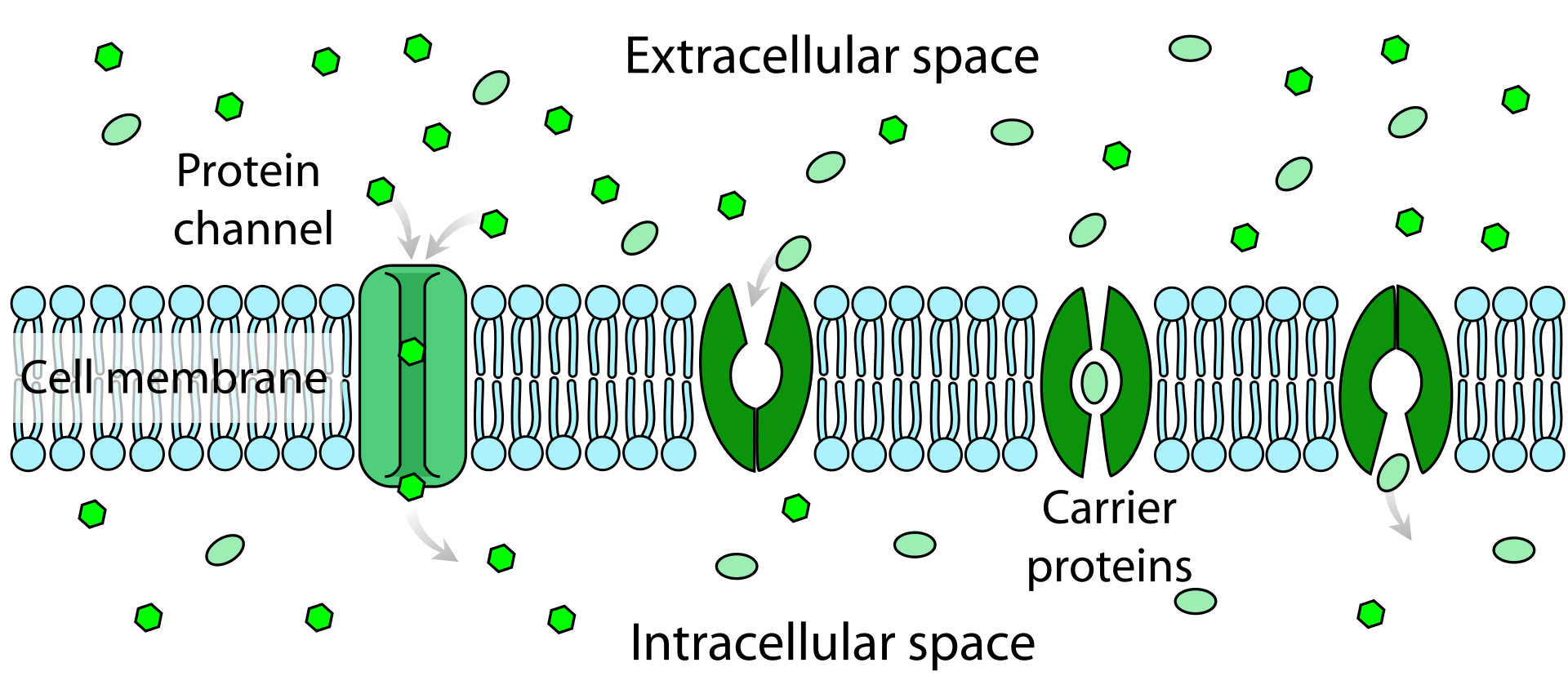
Facilitated diffusion
n., [fəˈsɪl ɪˌteɪtɪd dɪˈfjuːʒən]
Definition: A type of diffusion where membrane proteins facilitate the downhill movement of substances across the membrane
Table of Contents
Facilitated diffusion is the transport of substances across a biological membrane from an area of higher concentration to an area of lower concentration with the help of a transport molecule. Since substances move along the direction of their concentration gradient, chemical energy is not directly required. Examples of biological processes that entail facilitated diffusion are glucose and amino acid transport, gas transport, and ion transport. Facilitated diffusion is important because it regulates what goes in and what goes out of the cell. The plasma membrane is the cellular structure that is responsible for the selective movements of substances.
Facilitated Diffusion Definition
Facilitated diffusion is the passive movement of substances, such as biological molecules or ions, across a plasma membrane by means of a transport protein located in the plasma membrane. Since the movement of substances is from greater to lesser concentrations, chemical energy is neither used nor required.
Etymology
The term facilitated came from the Latin facilis, which in turn came from facio, meaning “do” or “make” and –”ilis”. The term diffusion came from the Latin diffusionem, diffusio, meaning “a pouring forth”. Synonyms: facilitated transport; passive-mediated transport.
Characteristics
Facilitated diffusion is one of the many types of passive transport. This means that it is a type of cellular transport where substances move along their concentration gradient. The difference in concentrations between areas creates a gradient that incites substances to inherently move to be distributed between the two areas to achieve equilibrium.
Because the movement is downhill (i.e. from higher to lower concentrations), chemical energy is not directly required. What drives facilitated diffusion, just like the other types of passive transport, is kinetic energy. Nevertheless, what characterizes facilitated diffusion from the other types of passive transport is the need for assistance from a transport protein lodged in the plasma membrane.
Facilitated Diffusion vs. Active Transport
Both facilitated diffusion and active transport need a concentration gradient to occur. Both of them are capable of transporting ions, sugars, and salts. They are also similar in the way that they use membrane proteins as transport vehicles. Permeases are an example of membrane proteins used in facilitated diffusion whereas membrane protein pumps (e.g. sodium-potassium pumps) are those used in active transport. Nevertheless, they differ in the direction of transport. In a mode of active transport, substances are transported from an area of low concentration to an area of high concentration. This uphill movement of substances in active transport requires and expends chemical energy in the form of ATP. In contrast, facilitated diffusion neither requires nor expends ATP. Rather, the kinetic or natural entropy of molecules drives the process.
Facilitated Diffusion vs. Simple Diffusion
Both facilitated diffusion and simple diffusion are types of passive transport. They move substances from an area of high concentration to an area of low concentration. However, the former is different from the latter in the way molecules are transported across the membrane. Facilitated diffusion requires membrane proteins to transport biological molecules.
Simple diffusion is one that occurs unassisted by membrane proteins. Since membrane proteins are needed for transport in facilitated diffusion, the effect of temperature is often more pronounced than in simple diffusion. The rate of the process also tends to be affected by saturation limits. (1) Furthermore, it relies upon the binding capacity of the membrane protein involved. In simple diffusion, the rate is more straightforward.
For more differences and similarities between facilitated diffusion and simple diffusion, see Table 1 below.
Table 1: Facilitated and Simple Diffusion – differences and similarities | |
|---|---|
| Facilitated diffusion | Simple diffusion |
| A type of passive transport | A type of passive transport |
| Substances move from an area or region of higher concentration to an area or region of lower concentration | Substances move from an area or region of higher concentration to an area or region of lower concentration |
| Does not directly require chemical energy, e.g. ATP or GTP | Does not directly require chemical energy, e.g. ATP or GTP |
| Transport proteins required | Transport proteins not required |
| Rate is generally faster but affected by factors such as temperature and types of membrane proteins involved, and thus, may be affected by membrane protein inhibitors. | Rate is generally slower but more straightforward as it does not rely upon the binding capacity of membrane proteins with substances for transport |
| Polar molecules (e.g. glucose and amino acids), larger ions (e.g. sodium ions and chloride ions), and large nonpolar molecules (e.g. retinol) employ facilitated diffusion via membrane proteins across the plasma membrane | Small nonpolar molecules (e.g. oxygen, carbon dioxide) diffusing easily across the plasma membrane |
Transport Mechanisms

The lipid bilayer nature of the plasma membrane prevents just any molecules to pass across. It accounts for the hydrophobic region of the membrane and therefore prevents the passage of polar (hydrophilic) molecules. Small nonpolar (hydrophobic) molecules can diffuse with relative ease in the direction of their concentration gradient.
In contrast, large nonpolar molecules would not be able to do so easily. They employ certain membrane protein components such as membrane channels and carriers to cross. The types of facilitated diffusion may be based on the membrane proteins involved. For instance, facilitated diffusion by channel proteins (e.g. transmembrane channels) is one that uses membrane proteins that act as a pore in the lipid bilayer. These channels form by protein complexes that span across the plasma membrane, connecting the extracellular matrix to the cytosol, or across certain biological membranes that connect the cytosol to the organelle (e.g. nucleus, mitochondrion, chloroplast, endoplasmic reticulum, etc.).
Charged ions, for instance, use transmembrane channels as they can only be transported across membranes by proteins forming channels. Aquaporins, although they are also integral membrane proteins and act as pores on biological membranes, are involved in the transport of water molecules rather than solutes.
Facilitated diffusion by carrier proteins is one that utilizes transporters embedded in a biological membrane. They have a high affinity for specific molecules on one side of the membrane, such as the cell exterior. Upon binding with the molecule, they undergo a conformational change to facilitate the passage of the molecule to the other side, such as the cell interior.
Larger molecules are transported by carrier proteins (e.g. permeases) that change their conformation as the molecules are carried through. Carrier proteins, though, are involved not only in passive movements; they are also employed in the active transfer of molecules.
Examples
Glucose and amino acid transport
Glucose transport is a facilitated diffusion example. Since glucose is a large polar molecule, it cannot pass through the lipid bilayer of the membrane. Thus, it needs carriers called glucose transporters to pass through. The epithelial cells of the small intestine, for instance, take in glucose molecules by active transport right after the digestion of dietary carbohydrates. These molecules will then be released into the bloodstream via facilitated diffusion. The rest of the body takes in glucose by means of facilitated diffusion as well. Glucose transporters take glucose from the bloodstream into the cell. Similarly, amino acids are transported from the bloodstream into the cell by facilitated diffusion through the amino acid permeases.
Gas transport
The hemoglobin is the carrier protein in the red blood cells whereas the myoglobin is the carrier in the red skeletal muscle cells. Both of these membrane proteins have an affinity for oxygen. Oxygen diffuses as a result of greater saturation pressure on one side of the membrane and less pressure on the other side. A similar mechanism occurs with carbon monoxide and carbon dioxide. (2) In adult humans, the red blood cells lack a nucleus and other organelles in order to maximize space for hemoglobin that can bind with oxygen or carbon dioxide.
Ion transport
Ions, although small molecules, cannot diffuse through the lipid bilayer of biological membranes because of the charge they carry. Thus, they are transported in their concentration gradient by facilitated diffusion. Potassium ions, sodium ions, and calcium ions need membrane proteins that can provide a passageway. These proteins are referred to as ion channels (or gated channel proteins). These channels can allow the passage of ions down their concentration gradient at a very fast rate, often about 106 ions per second or more, without using chemical energy.
Importance
The unequal distribution of substances between the intracellular fluid and the extracellular fluid drives cellular transport, including facilitated diffusion. The movement between these two regions is an attempt to establish equilibrium.
In living organisms, this form of transport is essential to regulate what goes in and what goes out of the cell. The plasma membrane surrounding the cell is responsible for this crucial biological function. Facilitated diffusion in biology systems is, therefore, crucial to maintaining homeostatic optimal levels of molecules and ions inside the cell.
Try to answer the quiz below to check what you have learned so far about facilitated diffusion.
Further Reading
- Passive transport
- Active transport
- Diffusion
- Carrier protein
- Selectively-permeable membrane
- Symport
- Permease
References
- Friedman, M. (2008). Principles and models of biological transport. Springer.
- Wittenberg, J. B. (January 1966). “The molecular mechanism of hemoglobin-facilitated oxygen diffusion”. J. Biol. Chem. 241 (1): 104–14.
- TRANSPORT IN AND OUT OF CELLS. (2019). Retrieved from Estrellamountain.edu website: https://www2.estrellamountain.edu/faculty/farabee/BIOBK/BioBooktransp.html
- facilitated diffusion. (2019). Retrieved from Cuny.edu website: https://opened.cuny.edu/courseware/lesson/626/student/?task=4
- DIFFUSION THROUGH A CELL MEMBRANE. (2019). Retrieved October 31, 2019, from Utk.edu website: http://www.tiem.utk.edu/~gross/bioed/webmodules/diffusion.htm
© Biology Online. Content provided and moderated by Biology Online Editors




